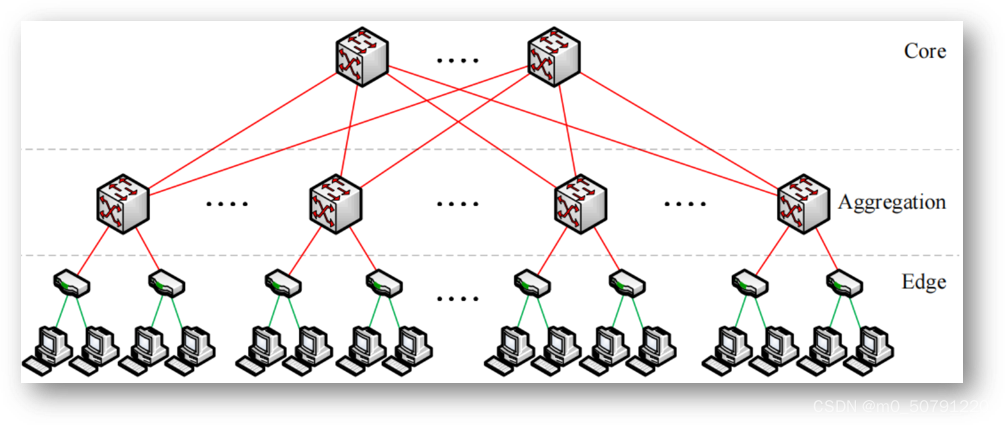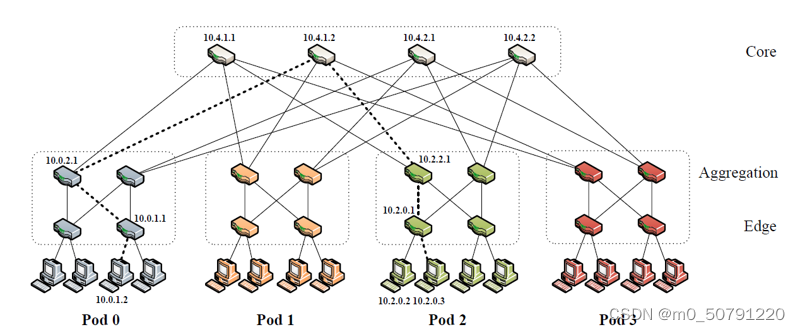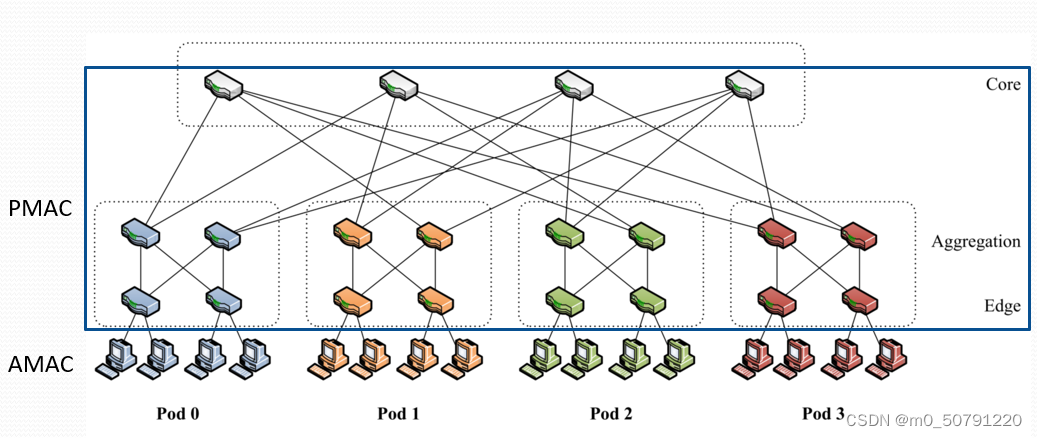CDN
Fat-tree
- desired properties for DCN
- Scalable interconnection bandwidth:可扩展的互联带宽
- Economies of scale
- Backward compatibility:向后兼容 - Current Data Center Network Topologies

- Problems of the Topology
- Oversubscription:
- Multi-path Routing
- Cost
- fat-tree

- addressing
pod switches 编码:10.pod.switch.1
core switches:10.k.j.i - Routing Algorithm
PortLand
- Why existing L2 and L3 techniques can not satisfy R1-5 for the cloud datacenter?
- R1、R2
Can be satisfied with a single layer 2 fabric, but layer 2 fabrics not scalable, need to support broadcasting.
A layer 3 fabric can not support VM migration . - R3
Layer 2: Require large number of MAC forwarding table entries, not feasible - R4、R5
Layer 2 and 3 protocols (i.e. ISIS, OSPF) are broadcast based, not efficient enough
- R1、R2
- PMAC address

48-bit PMAC: pod:position:port:vmid 16:8:8:16bit
-
Location discovery
-
How PortLand satisfies R1 – R5
Helios
- Difference between packet switching and optical switching
- Tradeoff between cable length and bandwidth
- Optical fiber doesn’t have length limit
- What is the benefits and problem of using packet switching
- Non-blocking switching
- Cost, power, complexity, oversubscription for the worse case
- What is the benefit and constraint of using MEMS-based optical switching with WDM in datacenter network
- Consuming less power, rate agnostic, can carry multiple channels with WDM
- Can only forward signal from one port to another port, but block rest
- Rate-agnostic
- Need time to reconfigure its topology
Protocol
MPTCP
-
What is the benefit of MPTCP, how it works?
- benefit
- MPTCP design objective Capable of using multiple network paths for a single connection.
- Be able to use the available network paths at least as well as regular TCP, but without starving TCP.
- Be as usable as regular TCP for existing applications (no need to change ends).
- work
- MPTCP acts as a shim layer between the socket interface and one or more TCP subflows
- benefit
-
Concerns of MPTCP congestion control 拥塞控制
- Fairness with TCP flow.
- Adapt to load change.
- Discover and make use of less congested path.
-
How EWTCP, Coupled, and MPTCP behaves
- EWTCP: subflows are independent, one flow congested, other subflows will not be more aggressive.
- Coupled: only use the least congested path, can not discover other paths when they are good.
- MTTCP
QUIC
- How QUIC reduces handshake latency?
- 0-rtt handshake
- How QUIC reduces head of line blocking latency?
- Multiple streams multiplex a connect.
- How QUIC avoids retransmission ambiguity?
- Each packet has a new packet number, always increasing.
- Loss indicates by offsets
CCP
- Why congestion control shouldn’t be put in kernel
- Learning-based congestion control algorithms are difficult to be implemented in kernel
- Kernel TCP stack is only one example of datapath
- Hard to provide new capacities
- Benefit of off-datapath congestion control
-
Write-once, run-anywhere:write a congestion control algorithm once and run it on any datapath that supports the specified interface.
-
Higher pace of development: focus on the algorithmic essentials without worrying about the details and data structures of the datapath
-
New capabilities
-
- Control loop of CCP
- Understand the exemplary CCP code
SDN
Ethane
- Principles
- Govern by policy with high-level names:The network should be governed by policies declared over high-level names.
- Policy determine path:Policy should determine the path that packets follow.
- Know packet’s origin:The network should enforce a strong binding between a packet and its origin.
- Component of Ethane
- Controller
- Contains the global network policy and topology
- Performs route computation for permitted flows.
- Ethane switch
- Simple and dumb
- Consisting of a simple flow table and a secure channel to the Controller
- Forward packets under the instruction of the Controller.
- Controller
- Name binding in a Ethane network
- How two hosts communicate in a Ethane network?
- Controller replicating
- Policy Language
OpenFlow
- How SDN works?
- Three layers in SDN
- Where OpenFlow is located?
- How to use SDN?
NOX
-
Why flow-based granularity is better than the packet-level and the prefix-level ones?
- packet-level: infeasible to implement across any sizable network. No scalability
- prefix-level: not allow sufficient control, since all packets between two hosts would have to follow the same path. No flexibility
- flow-based granularity
- Once control is exerted on some packet, subsequent packets with the same header are treated in the same way
-
In NOX, which is the global network view, which is not?
- the global network view
- Switch-level topology
- Name binding
- not
- Traffic
- the global network view
B4
- Why Google wants to build a WAN?
- We control the applications, servers, and the LANs all the way to the edge of the network
- Most bandwidth-intensive applications can adapt their transmission rate based on available capacity
- No more than a few dozen data center deployments, making central control of bandwidth feasible
- B4 network’s system architecture.
- Each site
- Global layer
- TE over BGP
- TE algorithm
- Forwarding rules
FIN
DONA
- How the host-centric networking causes the persistence, availability, and authentication issues.
- Name and Data in DONA
- P: L
- data: pubic_key: signature
- How a data is authenticated in DONA?
- sign the data hash with public_key, compare with signature
- hash public_key, compare with P
- REISGER and FIND operations.
CCN
- Three components of the CCN node, two types of packets in CCN.
- How users request contents?
- How CCN node handles CCN packets?
- Interest
- Data
- How CCN name the content?
- URI-like, hierarchical names
- Names can be form a tree
Serval
- What are the features of the modern Internet service
- Multiplicity
- Dynamism
- The Serval abstraction
- ServiceID and FlowID
- Active socket vs. BSD socket
- Network stack
- Service table
- Flow table
- Service controller






















 1915
1915

 被折叠的 条评论
为什么被折叠?
被折叠的 条评论
为什么被折叠?








